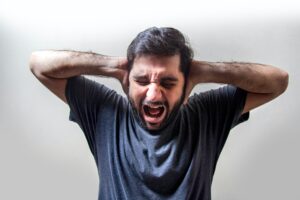Millions of people throughout the world suffer from anxiety disorders, which can significantly influence their day-to-day activities.
For general health and quality of life, it’s critical to identify and treat these illnesses’ symptoms.
This extensive guide will examine the various varieties of anxiety disorders.
In addition, we’ll offer useful tactics and ideas for controlling anxious symptoms.
What Is Anxiety Disorder?
Anxiety disorder is a mental health condition in which you experience ongoing, excessive fretting, fear, and unease that exceed what is acceptable or appropriate for a particular context.
It consists of an overpowering and unbearable feeling of dread that is frequently accompanied by bodily symptoms such as a faster heartbeat, perspiration, shaking, and trouble focusing.
Types of Anxiety Disorders
Anxiety disorders come in a variety of forms, each with distinct characteristics and signs. Here are the common types of anxiety disorders:
1. Generalized Anxiety Disorder (GAD)
Excessive and ongoing concern about regular occurrences and activities is a hallmark of GAD. Uncontrollable thoughts, agitation, irritation, tension in the muscles, and sleep difficulties are common in people with GAD.
2. Panic Disorder

Photo by Usman Yousaf on Unsplash
Recurrent and spontaneous panic attacks, which are extremely frightening events that result in physical symptoms, including rapid heart rate, chest discomfort, shortness of breath, dizziness, and an overwhelming feeling of impending doom, are a symptom of panic disorder. People with panic disorder frequently worry about having more panic attacks, because of which they cannot enjoy their life.
3. Social Anxiety Disorder (SAD)
The hallmark of SAD or social phobia, is an intense dread of being criticized, ashamed, or embarrassed in public. People with SAD may avoid interactions with others, which can cause serious distress and hinder everyday functioning.
4. Specific Phobias
Excessive and illogical fear of a certain thing, circumstance, or action characterizes specific phobias. Fears of high places, insects, flying, and needles are typical phobias. Specific phobia sufferers often go to tremendous measures to prevent their triggers.
Symptoms of Anxiety Disorders
For early detection and successful therapy of anxiety disorders, it is essential to recognize their signs. There are some universal signs to look out for, even though symptoms can vary as per the precise type of anxiety illness. The following are the primary groups of symptoms to watch out for:
1. Physical Symptoms
- Heart palpitations
- Breathlessness and chest tightness
- Aches and muscle tension
- Restlessness
- Fatigue
- Difficulty sleeping
- Upset stomach
- Nausea
2. Behavioral Symptoms
- Avoiding certain situations or places
- Rituals or compulsions
- Social withdrawal
- Isolation
- Difficulty making decisions
3. Cognitive Symptoms
- Excessive worry
- Rumination
- Racing thoughts
- Difficulty concentrating
- Irrational fears
- Forgetfulness
4. Emotional Symptoms
- Intense fear or panic
- Feelings of dread
- Irritability and mood swings
- Restlessness
- Difficulty controlling emotions
- Sense of danger
Managing Symptoms of Anxiety Disorders
In order to enhance general well-being and lessen the negative effects of anxiety on daily life, it is essential to manage the symptoms of anxiety disorders. The nature and degree of an individual’s anxiety problem may affect the specific treatment strategy, although the following broad techniques may be helpful:
1. Self-Care Practices
First and foremost, it’s crucial to incorporate self-care routines. Regular movement and exercise can ease tension and encourage relaxation. Developing sound sleep practices and getting enough rest is crucial for controlling anxiety symptoms.
Deep breathing, meditation, or yoga are all examples of techniques for relaxation that can be used to quiet the body and mind. In addition, eating healthy meals and abstaining from excessive coffee and alcohol use might improve general well-being.
2. Cognitive-Behavioral Therapy (CBT)
CBT, or cognitive behavioral therapy, is yet another powerful strategy. Through the identification and challenging of adverse thoughts, CBT aids individuals in changing them with realistic and uplifting ones.
In a safe and encouraging setting, exposure therapy gradually exposes patients to their anxieties and phobias. CBT includes learning stress reduction strategies and relaxation practices.
3. Medication Options
In some circumstances, medication choices may also be put into account. Selective serotonin reuptake inhibitors (SSRIs), an antidepressant, can help stabilize mood and lessen the symptoms of anxiety. For the temporary relief of serious anxiety symptoms, benzodiazepines may be given. However, due to the possibility of dependence and adverse effects, care must be taken.
4. Professional Support

Image by Drazen Zigic on Freepik
Having professional assistance, such as online therapy services, is crucial for treating anxiety problems. An environment of safety exists in individual treatment with a psychological practitioner to explore and address anxiety issues. Support groups and group therapy, including online therapy services, provide a community of support and the chance to learn from others going through similar struggles. Individuals can build coping mechanisms and problem-solving techniques with the aid of psychoeducation and skill development.
When to Seek Professional Help?
For anxiety disorders, knowing when to seek professional assistance is essential to getting the right support and care. Although the occasional anxiousness is acceptable, chronic and severe symptoms may point to the need for medical help. Here are a few indicators that it might be time to get assistance:
1. Persistent and Intense Symptoms
It is a good idea to seek professional assistance if your anxiety symptoms last for a long time (a few weeks or more) and have a major negative influence on your daily work, relationships, or general quality of life.
2. Interference with Daily Life
Professional help may be required if anxiety symptoms make it difficult for you to carry out daily tasks like job or school obligations, social interactions, or self-care.
3. Safety Concerns or Thoughts of Self-Harm
It is critical to get prompt medical assistance if you engage in dangerous activities or have suicidal or self-harming thoughts as a result of your anxiety. Contact a healthcare professional, a mental health helpline, or the neighborhood emergency department.
Conclusion
It’s critical to recognize and treat anxiety disorder signs in order to enhance general health and quality of life. People can seek the right support and assistance by learning the many forms of anxiety and their prevalent symptoms.
Effective management techniques, such as self-care routines, therapy alternatives, and daily coping techniques, can enable people to recover power and find comfort from the difficulties brought on by anxiety disorders. Keep in mind that professional help is accessible and that asking for it is a brave move toward greater mental health.


















